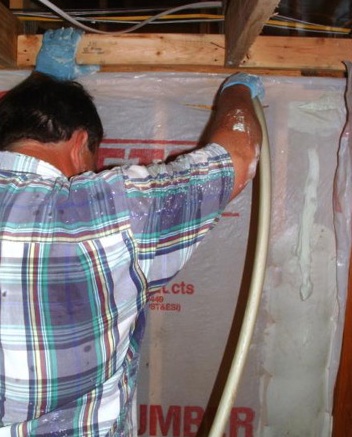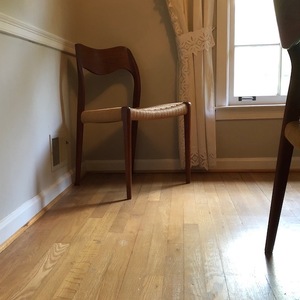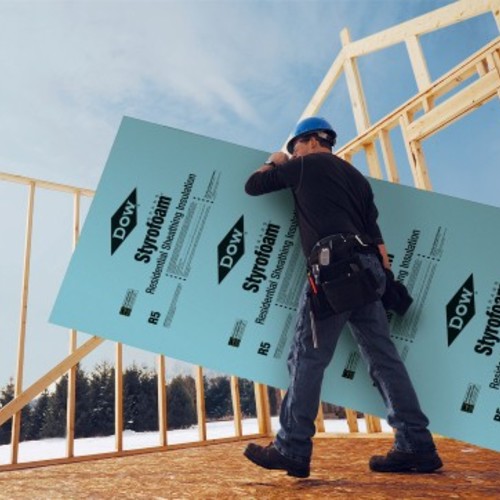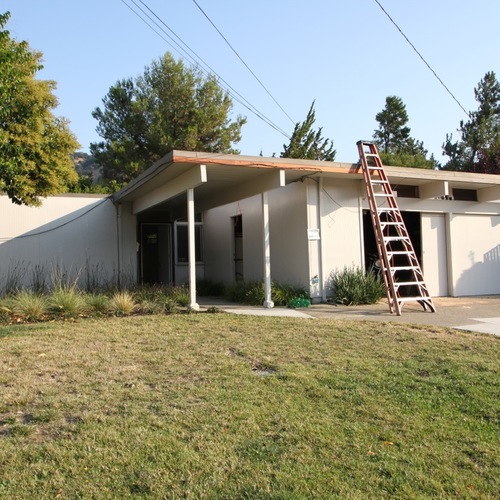
Image Credit: Air Krete, Inc.
[This blog has been edited to correct some information on Tripolymer Foam. I continue to wish for greater transparency in the manufacturing industry. -Alex Wilson]
In recent columns, we’ve looked at cellulose insulation as well as fiberglass and other batt insulation materials. The other option for filling wall and ceiling cavities is foam insulation that is sprayed into the cavity. There are several such materials that are used for this application, all installed by professional insulation contractors.
Polyurethane is by far the most common foam-in-place insulation material used for homes, but there are several quite different formulations. Closed-cell polyurethane has been around for decades, though the ingredients have changed considerably in the past 15 years as ozone-damaging blowing agents were replaced with safer chemicals. The polyurethane is sprayed into the wall or ceiling cavity as a liquid (much like spray paint), and as the components mix they instantly expand, foaming to create the insulation. The material fully cures in a few hours to form a quite hard, high-density (2 pound per cubic foot) material. In a wall cavity, enough material is typically used to expand to several inches thickness, but not so much that the foam bulges beyond the inner face of the framing. Closed-cell polyurethane insulates to between R-5.8 and R-6.8 per inch—a considerably higher insulating value than any other cavity-fill insulation.
Polyurethane insulation is also available in an open-cell formulation. The Canadian company Icynene pioneered this material and is one of the leading producers; Demilec is another. The foam is installed in a similar fashion as closed-cell foam, except that the lower-density foam is usually sprayed so that it fully fills or slightly overfills the cavity—and then the extra is shaved off flush with the inner face of the framing using a specialized tool. The cured foam has a density of about a half-pound per cubic foot and insulates to between R-3.6 and 3.8 per inch. Open-cell polyurethane uses a lot less raw material than closed-cell polyurethane, and it is usually installed to fully fill the cavity, so the overall energy performance is often fairly comparable. It is also available in a more slowly expanding formulation that can be poured into a wall cavity—so it can be used for retrofitting uninsulated finished walls.
Several manufacturers offer biobased formulations of polyurethane insulation in which a portion of one of the polyurethane components is derived from soybean oil, rather than petroleum hydrocarbons. Biobased materials are attractive environmentally because they are renewable, but they also have the unintended negative consequence of raising food prices.
Spray polyurethane insulation, whether closed-cell or open-cell, provides an excellent air seal. If properly installed, it contributes to a very airtight house. In fact, most professionals feel that a separate air/vapor barrier is unneccessary, because the foam will block almost all air and moisture flow on its own.
Besides polyurethane, there are several other foam-in-place insulation materials. One of these, known as Tripolymer foam, is used primarily to fill concrete blocks in commercial construction. It is made from foamed phenol-urea formaldehyde, so it may release some hazardous formaldehyde into the building—but apparently less than an older formulation of urea-formaldehyde foam insulation (UFFI) that resulted in very significant formaldehyde offgassing.
Finally, there is a foam-in-place, cementitious insulation, Air Krete, that is made from magnesium oxide (derived from seawater) and ceramic talc mined in upstate New York. Air Krete is totally fireproof, mold-resistant, and does not offgas any volatile chemicals, so it is popular among people suffering from chemical sensitivity. Unfortunately, there are few trained installers, so it may be expensive to use this alternative. (The closest installer to Brattleboro is Eco-Safe Insulation in Northfield, VT, near Montpelier; 802-485-9119.) Other than availability, the biggest problem with Air Krete is that the cured foam is fairly fragile; if exposed to frequent vibration, such as along a busy highway, the foam can begin to disintegrate, reducing its performance. The manufacturer is working to solve this problem.
Whatever the type of cavity insulation used in a house, it is important to remember that it is part of a system. Next week we’ll look at rigid boardstock insulation that can be used along with cavity-fill materials to achieve extremely well-insulated walls and roofs.
Weekly Newsletter
Get building science and energy efficiency advice, plus special offers, in your inbox.















18 Comments
UFFI
Alex you state that "UFFI is no longer produced." I suggest that you do a little more research before making such a assumption. The process is alive and well in USA, Canada, Europe, United Kingdom, New Zealand and other countries.
Here in NZ it has been operating without problems since 1979.
UFFI in the U.S.?
John,
I'd be interested to know why you think that UFFI is "alive and well in the U.S.A. [and] Canada."
A great many sources can be cited that show your statement to be false. For example, this comes from the "UREA FORMALDEHYDE FOAM INSULATION (UFFI)" fact sheet published by the Connecticut Department of Public Health: "In 1981, as a result of these findings, the installation of UFFI was banned in Connecticut."
http://www.ct.gov/dph/lib/dph/environmental_health/eoha/pdf/uffi.pdf
Here's some information from the Canada Mortgage and Housing Corporation: "During the 1970s, when concerns about energy efficiency led to efforts to improve home insulation in Canada, UFFI became an important insulation product for existing houses. Most installations occurred between 1977 and its ban in Canada in 1980."
http://www.cmhc-schl.gc.ca/en/co/maho/yohoyohe/inaiqu/inaiqu_008.cfm
Can you please name a UFFI manufacturer or UFFI installer in the U.S. or Canada?
Perhaps foamed phenol formaldehyde?
I concur with Martin that UFFI is no longer produced or used in North America. I happened to be working in western Canada when problems with UFFI emerged and the Canadian government spent tens or maybe hundreds of millions of dollars to remove insulation that they had a few years earlier spent (a lot less) to install.
I believe that when UFFI largely disappeared from the market, some UFFI manufacturers modified their formula to include a foamed phenol formaldehyde component. But I have found it very hard to confirm if this is the case. The foam insulation materials I'm referring to are used primarily in commercial construction--often for filling concrete masonry units. Foamed phenol formaldehyde would emit quite a bit less formaldehyde than UFFI, so such manufacturers may be able to reasonably claim that products emit little or no formaldehyde.
UFFI is alive, well and growing today in the US
Despite being overturned in 1983, the CPSC ban of UFFI in 1982 and subsequent bans and restrictions implemented by a few states attached a stigma to UFFI that is slowly being overcome with advanced chemistry and focused marketing through well trained and equipped authorized contract installers. As a result some UFFI products may be properly described as 'ultra-low emission' foam in terms of their potential to emit free formaldehyde. Some experts, including attorneys, suggest the issue ought be revisited in light of the quality of UFFI available today.
Five US manufacturers offer their own brands; additionally, some private lablel brands are supported by some of the manufacturers. Manufacturers currently in production include:
cfiFOAM, Inc., Knoxville, TN
Tailored Chemical Products, Hickory, NC
C. P. Chemical Comapny, White Plains, NY (Claim their foam is not UFFI; Health Canada says it is.)
Polymaster, Inc., Knoxville, TN
Thermal Corp. of America, Mt. Pleasant, IA
UFFI in Canada
Just ask any of the 700+ suckers in Ontario Canada if uffi is alive and well......There is now a 500 million dollar class action in the works!
UFFI in Canada
Yes, Retrofoam made by Polymaster, was being installed in Ontario, Canada, Its UFFI, They have been shut down by Healh Canada since it was found out in the beginning of 2009
UFFI In Canada
A $500M pot of gold glittering at the end of a rainbow may blind some to products by some manufacturers that hardly shrink or emit. Those manufacturers are doing well in the US.
UFFI
The CP chemical company so far is the only one now that does NOT use formaldehyde in there process of making there resin. they used to back in the early 70 and before. since the mid 70s CP has been making the resin with OUT formaldehyde. as of September 2010 CP or Tripolymer is the only foam in place product legal in California.
So Bob, John et.al, What
So Bob, John et.al, What exactly is the R-value of Airfoam now that the claim of RSI 2.9 has been removed from the Airfoam website? Is $3 per square foot a fair price for insulation of unknown performance. Clearly you don't have any competition in NZ
UFFI foam shrinks
http://www.branz.co.nz/cms_display.php?sn=92&st=1&pg=4978
It shrinks without a doubt and even when installed by "well trained and equipped authorized contract installers" (Bob's words). The performance goes down dramatically when the shrinkage is included.
ASTM C518 conductivity results are not sufficient because shrinkage is an inherent part of the product.
Walter Hasselman, who owns
Walter Hasselman, who owns C.P. chemical filed a patent in 1980 number 4345061. You can look it up on freepatentonline.com. It is titled Process for the preparation of phenol-urea-formaldehyde. Boy after reading it it sure sounds like it is being used in the insulation foam.
tripolymer shrinks!
I just had Tripolymer by CP chemical installed in my house and after on week it had shrunk up two 5/8 of and inch from the studs and over and inch on top! After having the installer try to fix it twice I am removing the finished drywall and removing the product completely, and replacing it with some thing that works! I have tried to get in touch with CP via email and phone and they wont get back to me? It also shrunk from the sheathing and drywall creating moisture in the wall. It is now below 0 outside so moisture has formed on the sheathing because of heat loss, remember it disolves with water? Don't make the same mistake I made don't waste your money!
Tripolymer
Anonymous, who was your installer? Where are you located?
UFFI foam shrinks
John & Bob, have you worked out the ACTUAL R-value yet
Hint: its not thickness divided by conductivity - its a lot less than that
http://www.nachi.org/uffi-insulation-inspection.htm
http://www.nrc-cnrc.gc.ca/obj/irc/doc/pubs/nrcc23440/nrcc23440.pdf
Tripolymer failure?
Anonymous, Please post about your Tripolymer failure. And please let us know how you were able to detect these problems given that typically it's applied in wall where you can not see it.
To Frank...
CfiFOAM's R-values are shrinkage-adjusted per 16CFR460 based on ASTM C518 testing using accepted heat transfer calculations. The tone of your reply is both arrogant and offensive.
UFFI by Tripolymer
The Tripolymer product was found by Health Canada to contain Urea Formaldehyde. Testing performed for the state of Connecticut confirms that Tripolymer emits significant levels of formaldehyde, nullifying their claims that no formaldehyde is used in the manufacturing process of their foam.
Alex Wilson
Better check your facts. Your information is incorrect.
Log in or create an account to post a comment.
Sign up Log in